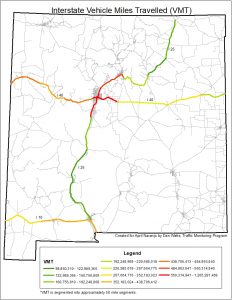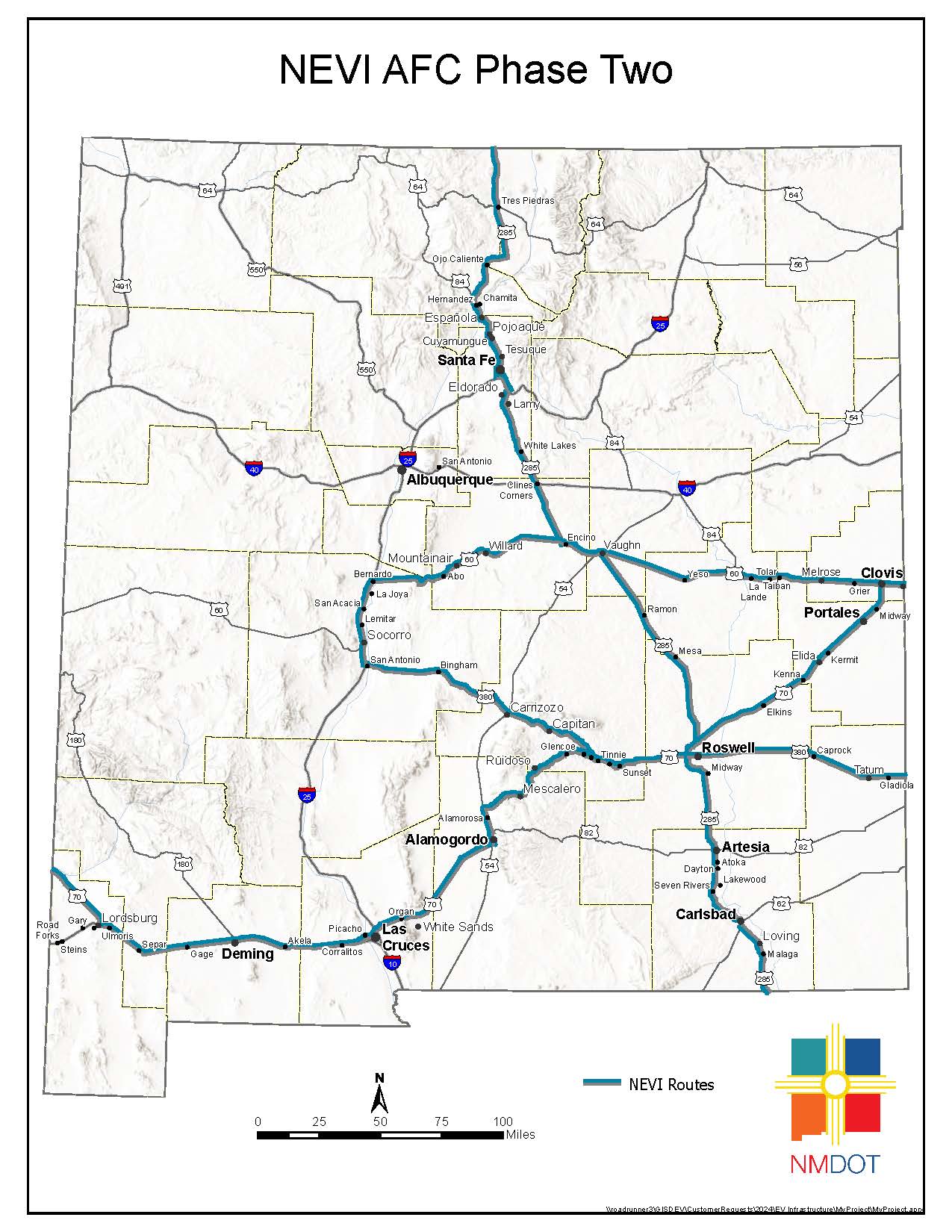New Mexico Electric Vehicles
National Electric Vehicle Infrastructure (NEVI)
The Bipartisan Infrastructure Law, enacted as the Infrastructure Investment and Jobs Act (IIJA), Public Law 117-58 (Nov. 15, 2021), includes important new programs to address climate change by reducing carbon emissions. Among these programs is the National Electric Vehicle Infrastructure (NEVI) Formula Program that will provide funding to states to strategically deploy electric vehicle (EV) charging infrastructure and establish an interconnected network. These historic investments in EV charging infrastructure will put the United States on a path to a nationwide network of 500,000 EV chargers by 2030 and ensure a convenient, reliable, affordable, and equitable charging experience for all users.
New Mexico Department of Transportation (NMDOT) expects to receive around $38 million from this program over five years from the U.S. Department of Transportation (US DOT) to install EV charging infrastructure with a US DOT priority on Interstate highway locations.
2025 Electric Vehicle Infrastructure Grant Program
Now Open! Click here to view RFP
NEVI Phase Two CLOSED!
NATIONAL ELECTRIC VEHICLE INFRASTRUCTURE ELECTRIC VEHICLE CHARGING STATIONS
The Infrastructure Investment and Jobs Act (IIJA) enacted November 15, 2021, established the National Electric Vehicle Infrastructure Formula Program (NEVI Formula). The NEVI Formula provides $5 billion to states to strategically deploy 500,000 electric vehicle (EV) chargers by 2030, through an interconnected network to facilitate data collection, access, and reliability. The Federal Highway Administration (FHWA) Fact Sheet for the NEVI Formula can be found here: NEVI Formula Fact Sheet.
The RFP process will be open for sixty (60) days beginning July 18, 2024, through September 18, 2024, and are subject to all action by the NMDOT. RFPs must be submitted in PDF format no later than 11:59 P.M. (Mountain Daylight Time) on Wednesday, September 18, 2024.
NMDOT’s NEVI Competitive Selection Process Schedule:
| Activity | Date |
| RFP Release | 07/18/2024 |
| Deadline to submit additional written questions | 09/04/2024 |
| Deadline for responses to written questions | 09/11/2024 |
| Proposals Due | 09/18/2024 |
| Notice of Intent to Award | 10/11/2024 |
| Project Contract Execution | 11/01/2024 |
Phase 2 Frequently Asked Questions
Click the button below to download a complete list of questions.
Please submit a question for our FAQs section!
- Funding
- NEVI Formula Funding
- Deployment Plan
- Resources
- Public Engagement Presentations
- NEVI Phase 1 Closed
In November 2021, the Investment and Jobs Act (IIJA) allocated up to $7.5 billion over five years for states to enhance their Electric Vehicle charging infrastructure.
The electric vehicle infrastructure funding will help EV drivers to have regular access to charging stations to help avoid a situation where a driver could be stranded without services. Additionally, the added infrastructure will bolster tourism as EV vehicles become more popular nationwide.
There are two sources for funding: Federal Formula Funding and Discretionary Grants
New Mexico is allocated $5.6 million this year and expects $7 million each year for the next four years for a total of $38 million for EV infrastructure, including:
- Acquisition and installation of EV charging infrastructure and traffic control devices and signs.
- Operation and maintenance of EV charging infrastructure for up to five years.
- Data sharing about EV infrastructure to ensure long-term success of equipment installed under the formula program.
- Development activities related to acquisition or installation.
- Mapping and analysis to evaluate locations for charging infrastructure.
In preparation to execute NEVI funding and other program incentives, the state is currently developing a NEVI Plan and will host virtual meetings over the next months to allow the public and interested parties to provide comments and feedback. The NEVI Plan is due to the Federal government in August 2022.
Formula Funding Details
State agencies will not own, operate or maintain the charging infrastructure through the NEVI program. Instead, this funding will be used to incentivize private industry to build the corridors. The first round of Federal guidance specifies some finer details of the program, including distance between chargers, strength of chargers and other requirements.
Guidance requires formula funding to be prioritized on charging stations installed along designated Alternative Fuel Corridors, especially the interstate corridors, before being installed elsewhere. Currently New Mexico’s interstates are designated as “EV Corridor-Pending” status by the FHWA. The Secretary of the U.S. Department of Transportation is the decision authority on when corridor build out is complete.
Guidance also requires charging infrastructure to be open to the public or to authorized commercial motor vehicle operators from more than one company. Chargers cannot be located more than 1 mile from the interstate off-ramp and be no more than 50 miles apart from each other. There are also specifications for charger strength, with requirements for Direct Current Fast Chargers (DCFC) and 150kW and higher charging capacity in each location.
Additional guidance from the NEVI Program Joint Office is expected this summer
The New Mexico Department of Transportation (NMDOT) is working collaboratively with partners and stakeholders to develop the New Mexico National Electric Vehicle Infrastructure (NEVI) Plan. The plan is required by the Bipartisan Infrastructure Law (BIL), enacted as the Infrastructure Investment and Jobs Act (IIJA), to access National Electric Vehicle Infrastructure (NEVI) formula program funding. The NM NEVI Plan is due to the Federal Highway Administration (FHWA) by August 1, 2022.
Funds must be used for:
- The acquisition and installation of EV charging infrastructure to serve as a catalyst for the deployment of such infrastructure and to connect it to a network to facilitate data collection, access, and reliability;
- proper operation and maintenance of EV charging infrastructure; and
- data sharing about EV charging infrastructure to ensure the long-term success of investments made under the program.
Utility Company Contacts:
Utility Company Contact Information
Request for nomination: www.fhwa.dot.gov/environment/alternative_fuel_corridors/nominations/2022_request_for_nominations_r6.pdf
State by State Funding for NEVI:
www.fhwa.dot.gov/bipartisan-infrastructure-law/evs_5year_nevi_funding_by_state.cfm
Wage and Hour: https://www.dws.state.nm.us/en-us/Labor-Relations/Labor-Information/Wage-and-Hour
New Mexico Alternative Fuel Corridors: https://AlternativeFuelsCorridorRelease070120.pdf (nm.gov)
Interstate Vehicle Miles Travelled map

NMDOT NEVI Phase 1 of conditional awards in 17 counties to expand access to and reliability of electric vehicle charging in New Mexico!
NMDOT will establish Contracts with eligible entities for the installation, ownership, operation, maintenance, and reporting of NEVI-compliant electric vehicle (EV) charging stations across the three (3) main alternative fuel corridors (AFCs), Interstate 25, Interstate 40, and Interstate 10. Phase 1 is funded through a NEVI competitive program and NMDOT contracting and program administration process supports efficient and effective deployment infrastructure.

